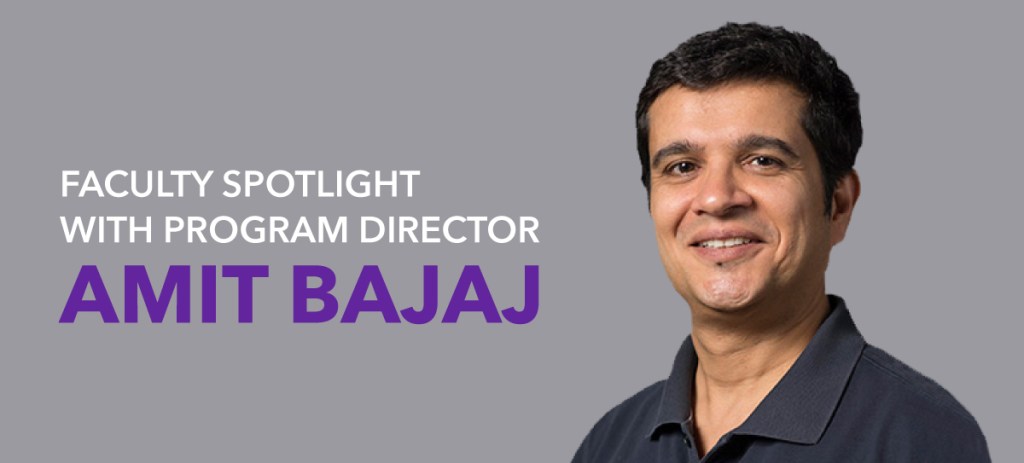Learning Occurs When Transformation Occurs: Program Director Amit Bajaj Discusses His Approach to Collaboration and Education

The online speech-language pathology program at Emerson College, Speech@Emerson, is built upon professors’ personal experiences that drive a passion for teaching speech-language pathology. As the program director for Emerson’s undergraduate Communication Disorders program, Associate Professor Amit Bajaj’s contributions are rooted in the philosophy of using collaboration to help others overcome communication disorders.
“Stuttering was what got me into the field. I have stuttered since childhood, so my own speech impairment led me to this,” he said. “At some point in time, I realized that I needed to choose my profession not from the outside in, but from the inside out.”
Dr. Bajaj thinks that many individuals are motivated to pursue training in communication disorders (speech-language pathology or audiology) because of their personal experiences.
Dr. Bajaj has worked as a teacher, researcher, and clinician. His areas of expertise are fluency disorders and speech science, and his research interests focus on stuttering. In the following Q&A, Dr. Bajaj discusses his background as an educator, how behavior influences speech, and what makes the Emerson program special.
What do you enjoy most about teaching?
I am drawn to breaking down information and communicating it in a way that is accessible. I love to support students and develop students along the way. That’s tremendously gratifying.
An axiom that drives my approach to pedagogy is that learning occurs by transforming information into knowledge. In my teaching experience, I have observed that while we can process surface information through minimal engagement, deeper features are difficult to process without a concerted and interactive engagement with the content, so that it is “transformed” in students’ minds.
I see my teaching role as providing students an array of learning opportunities that enable variable levels of engagement with the material. Relatedly, I evaluate my students’ learning using an array of testing tools that correspond with retaining both surface and deep features of the material.
Based on your research, what are some of the direct ways in which behavior influences the way people speak?
Language is a cognitive function, but it has a motor component as well. We see robust correlations between language complexity and speech-motor complexity. Typically, long and grammatically complex utterances require greater speech-motor coordination than short and simple sentences. This widely known observation, backed by research, is used in clinical work where speech-language pathologists (SLPs) help people who stutter practice a more fluent speech pattern by varying its language complexity.
Technology is changing education and the way people receive information. What are some of the priorities you kept in mind while helping to develop the curriculum for Speech@Emerson?
I’ll summarize our strengths as integration and collaboration. In both our graduate and undergraduate curricula, we strive to integrate academic knowledge and the clinical skills. To this end, we are planning immersive experiences for students in the online program to come to campus and go through some intensive clinical trainings. In addition to building preparedness, another objective is to integrate our online and on-ground learning communities. Such initiatives are possible because the academic faculty and the clinical faculty collaborate on pretty much all aspects of the department, from reading the admissions applications all the way to graduating students after the comprehensive exams. There’s no real separation between the clinical and the academic faculty.
Having developed two online courses, I see the power that online education has to deliver our curriculum to students across various locations. The hybrid 2U format is very attractive because it allows us to leverage the permanent and portable nature of online material along with the social, real-time environment of the live sessions.
What thoughts do you have to share with those interested in becoming speech-language pathologists through Speech@Emerson?
To become an SLP, you obviously have to be drawn to working with people. That’s going to be pretty important; your people skills are key. Speech@Emerson wants students to be creative and wants to see them incorporate the research that has been done in the area.
It is also a field where you can work across the age span quite a bit. You can work in different facilities—schools, hospitals, private practice, and telepractice. Having lots of workplace options implies several options for the kind of lifestyle you want to have at work, so it’s a good profession to get into from that perspective.
This interview was edited for brevity and clarity.
Citation for content: Speech@Emerson, the online speech pathology master’s program from Emerson College


